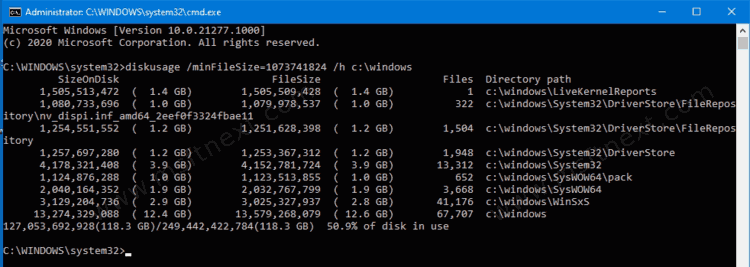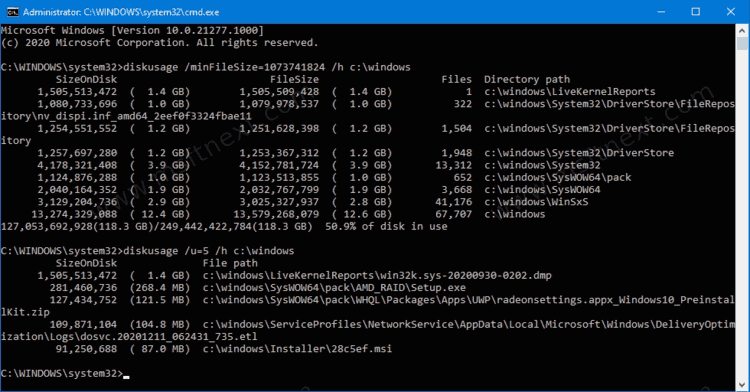What is the DiskUsage tool in Windows 10 (diskusage.exe).
Windows 10 to get a built-in disk space analyzer tool, named DiskUsage. It is already available for testing in pre-release builds, starting in build 21277.
Windows 10 Build 21277 is a Dev Channel release which brought a new tool for testing by users. For the first time Windows includes a console disk space analyzer utility. Microsoft has quietly added to the OS.
What is the DiskUsage tool
This app can scan your folders or even entire drive and display the used space by each folder.
DiskUsage – Disk Usage Description: Summarize disk usage recursively for the given directory.
You can find the DiskUsage binary is located at C:\Windows\System32\diskusage.exe. It includes a built-in user guide which you can see by running diskusage /?.
Let’s take a look on how it works.
How to use DiskUsage on Windows 10
When running Disk Usage without specifying command line arguments, it will display file and folder sizes in bytes. It is not useful to be read by humans. To display size in more traditional units like MB, GB, etc, add the /h switch. See the screenshot below.
Note: The tool requires administrative privileges, so first open an elevated command prompt.
To find directories in C:\Windows that are larger than 1GB, type and run the following command:
diskusage /minFileSize=1073741824 /h c:\windows
💡Tip: 1073741824 is 1GB in bytes.

In the above screenshot Disk Usage has displayed all folders which take more than 1GB on the drive.
Disk Usage also includes a few switches to list the top N folders and files on the drive or in a directory.
- diskusage /t=5 /h c:\windows – lists top 5 large directories for the specified location.
- diskusage /u=5 /h c:\windows – lists top 5 large directories for the specified location.
Unfortunately, the above commands are buggy and doesn’t show what they intend.

Finally, Disk Usage allows specifying a configuration file that will keep defaults for the options you want to always use with the app, e.g. the /h switch. You can also customize the output and exclude certain files and folders from being processed.
While DiskUsage is still under development, and doesn’t work like a charm yet, it is a great fact that such a tool is already in Windows 10. The official announcement would shed some light on it.
